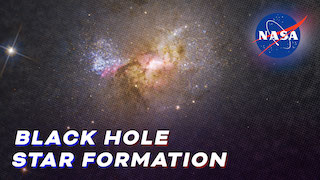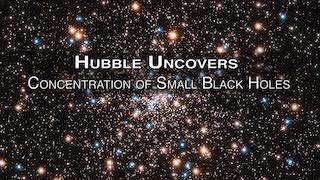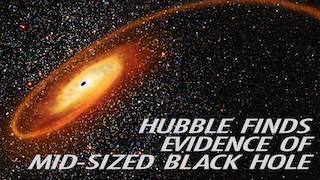Universe
ID: 14350
Astronomers using NASA’s Hubble Space Telescope have come up with what they say is some of their best evidence yet for the presence of a rare class of “intermediate-sized” black hole that may be lurking in the heart of the closest globular star cluster to Earth, located 6,000 light-years away.
Like intense gravitational potholes in the fabric of space, virtually all black holes seem to come in two sizes: small and humongous. It’s estimated that our galaxy is littered with 100 million small black holes (several times the mass of our Sun) created from exploded stars. The universe at large is flooded with supermassive black holes, weighing millions or billions of times our Sun’s mass and found in the centers of galaxies.
A long-sought missing link is an intermediate-mass black hole, weighing in somewhere between 199 and 10,000 solar masses. How would they form, where would they hang out, and why do they seem to be so rare?
For more information, visit https://nasa.gov/hubble.
Music Credit
Tesseract by Cody Johnson [ASCAP] and Gina Kouyoumdjian [BMI] via Emperia Alpha Publishing [ASCAP], Emperia Beta Publishing [BMI], and Universal Production Music
Animation Credit:
Computer Representation of the Stellar Motions in the Core of M4:
Mattia Libralato (AURA/STScI for ESA)
Black Hole accreting material animation by Aurore Simmonet.
Hubble Hunts for Intermediate-Sized Black Hole Close to Home
Like intense gravitational potholes in the fabric of space, virtually all black holes seem to come in two sizes: small and humongous. It’s estimated that our galaxy is littered with 100 million small black holes (several times the mass of our Sun) created from exploded stars. The universe at large is flooded with supermassive black holes, weighing millions or billions of times our Sun’s mass and found in the centers of galaxies.
A long-sought missing link is an intermediate-mass black hole, weighing in somewhere between 199 and 10,000 solar masses. How would they form, where would they hang out, and why do they seem to be so rare?
For more information, visit https://nasa.gov/hubble.
Music Credit
Tesseract by Cody Johnson [ASCAP] and Gina Kouyoumdjian [BMI] via Emperia Alpha Publishing [ASCAP], Emperia Beta Publishing [BMI], and Universal Production Music
Animation Credit:
Computer Representation of the Stellar Motions in the Core of M4:
Mattia Libralato (AURA/STScI for ESA)
Black Hole accreting material animation by Aurore Simmonet.
Related
Credits
Paul Morris (KBR Wyle Services, LLC): Lead Producer
Aaron E. Lepsch (ADNET Systems, Inc.): Technical Support
Aaron E. Lepsch (ADNET Systems, Inc.): Technical Support
Please give credit for this item to:
NASA's Goddard Space Flight Center. However, please credit individual items as indicated above.
NASA's Goddard Space Flight Center. However, please credit individual items as indicated above.
Short URL to share this page:
https://svs.gsfc.nasa.gov/14350
Keywords:
SVS >> Hubble Space Telescope
SVS >> HST
NASA Science >> Universe
https://svs.gsfc.nasa.gov/14350
Keywords:
SVS >> Hubble Space Telescope
SVS >> HST
NASA Science >> Universe














